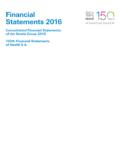Transcription of Financial Capability in the United States 2016
1 July 2016 Financial Capability in the United States 2016 Financial Capability in the United States 2016 1 ContentsIntroduction 21. Making Ends Meet 4 Spending vs. Saving 6 Indicators of Financial Stress 6 Medical Expenses 8 Financial Fragility 10 Sources of Income 112. Planning Ahead 13 Rainy Day Funds 13 Budgeting and Planning 13 Planning for Retirement 15 Planning for College 17 Investments 18 Risk Preferences 183. Managing Financial Products 19 Banking and Payment Methods 19 Home Ownership and Mortgages 20 Credit Cards 21 Student Loans 22 Non-Bank Borrowing 25 Debt 26 Credit Scores 274. Financial Knowledge and Decision-Making 28 Financial Literacy 28 Self-Perceptions of Financial Knowledge 31 Self-Perceptions vs.
2 Financial Behavior 31 Financial Education 32 Conclusion 34 Background and Methodology 35 Authors 36 Acknowledgments 36 Financial Capability in the United States 2016 2 IntroductionThe economy has grown slowly but steadily over the six years since the first National Financial Capability Study (NFCS) was conducted in 2009. And in the three years since the 2012 NFCS, the private sector has added jobs at an average rate of about 200,000 per month. At the time of the fielding of the current NFCS, which took place from June through October of 2015, unemployment and inflation were both low by historical standards.
3 Meanwhile, the stock market reached new highs in mid-2015 while interest rates remained generally this relatively positive economic background, it is not surprising that the 2015 NFCS shows evidence of diminished Financial stress and improved Financial satisfaction among American adults in comparison to the 2012 and 2009 studies. For example, the percentage of Americans who find it difficult to make ends meet has declined, as has the number of homeowners whose home values are underwater ( , worth less than they owe in mortgage debt).Wealth and income inequality in the United States , however, is at an extreme not seen since before World War Because of this, it is necessary to look beyond the mean statistics in order to understand the complete picture of Americans Financial status.
4 While many Americans are benefiting from the economic recovery of recent years, real median household income is still catching up to its pre-recession level. The 2015 NFCS shows that large segments of society continue to face Financial difficulties, particularly minority populations and those without a college Capability is a multi-dimensional concept that encompasses a combination of knowledge, resources, access, and habits. The NFCS is designed to understand and measure a rich, connected set of perceptions, attitudes, experiences, and behaviors across a large, diverse sample in order to provide a comprehensive analysis.
5 As with previous waves, the 2015 NFCS has been updated to include questions on additional topics that are relevant today, such as student loans and medical costs, while maintaining key measures to enable tracking comparisons over time. 1. Chad Stone, Danilo Trisi, Arloc Sherman, and Brandon DeBot, A Guide to Statistics on Historical Trends in Income Inequality, Center on Budget and Policy Priorities, October 26, many Americans are benefiting from the economic recovery of recent years, real median household income is still catching up to its pre-recession level. The 2015 NFCS shows that large segments of society continue to face Financial difficulties, particularly minority populations and those without a college Capability in the United States 2016 3 Drawing on data from the 2015, 2012, and 2009 NFCS State-by-State Surveys, each of which were nationwide online surveys of more than 25,000 American adults2, this report3 focuses on the following four key components of Financial Capability :1.
6 Making Ends Meet. The 2015 study shows a continuation of some of the positive trends observed in 2012. Fewer Americans find it difficult to cover their expenses and pay their bills, and more are satisfied with their overall Financial condition. However, new questions in the 2015 NFCS indicate that over a quarter of Americans have avoided some kind of medical service in the past year due to cost Planning Ahead. The percentage of Americans who say they have set aside three months worth of living expenses in case of an emergency is up to 46% from 40% in 2012. But only 39% report having ever tried to figure out how much they need to save for retirement, and over half worry about running out of money in Managing Financial Products.
7 New homebuyers are less leveraged: the percentage of recent home buyers (past 5 years) who made a down payment of over 20% of the purchase price is up to 33%, from 29% in 2012 and 24% in 2009. Also, for the first time since the NFCS was fielded, more than half of credit card users say they always pay their balance in full each month. However, among student loan holders with payments due, 37% have been late with a payment at least once in the past year, and 25% more than once. 4. Financial Knowledge and Decision-Making. The percentage of respondents who are able to answer at least 4 of 5 Financial literacy quiz questions correctly shows a slight downward trend since 2009, despite the fact that Americans perceptions of their own Financial knowledge have become more positive over the same time with previous years, the 2015 NFCS finds that measures of Financial Capability continue to be much lower among younger Americans, those with household incomes below $25,000 per year, and those with no post-secondary educational experience.
8 African-Americans and Hispanics, who are disproportionately represented among these demographic segments, also show signs of lower Financial Capability , making them more Selected findings are also presented for sub-samples ( , by age, gender, ethnicity, etc.). In all such cases, each sub-sample consists of at least 100 respondents or Percentages shown in this report may not always add up to 100% due to rounding and/or Don t know and missing with previous years, the 2015 NFCS finds that measures of Financial Capability continue to be much lower among younger Americans, those with household incomes below $25,000 per year, and those with no post-secondary educational experience.
9 Financial Capability in the United States 2016 41. Making Ends MeetThe ability to make ends meet is a central component of Financial Capability , encompassing the extent to which people balance monthly income and expenses, and how they deal with everyday Financial matters. Findings from the National Financial Capability Study suggest that Americans ability to make ends meet is at least partly influenced by general economic conditions. When the first NFCS was conducted in 2009, the was still in the grip of the Great Recession. During that year, GDP shrank and unemployment rose to levels not seen in the in over 25 years, as the figure below shows.
10 By 2012, the economy was growing modestly, and continued to do so through 2015. Unemployment rates have declined steadily from their peak in Source: Department of Commerce Bureau of Economic Analysis, Percent Change from Preceding Period in Real Gross Domestic Product, Annual Data from 2009 to Source: Department of Labor Bureau of Labor Statistics, Labor Force Statistics from the Current Population Survey, Annual Average Unemployment Rates from 2009 to Domestic Product4 and Unemployment5 2009 2015 % Change in GDP0 Unemployment rate 2010 2011 2012 2013 2014 ability to make ends meet is a central component of Financial Capability , encompassing the extent to which people balance monthly income and expenses, and how they deal with everyday Financial matters.







